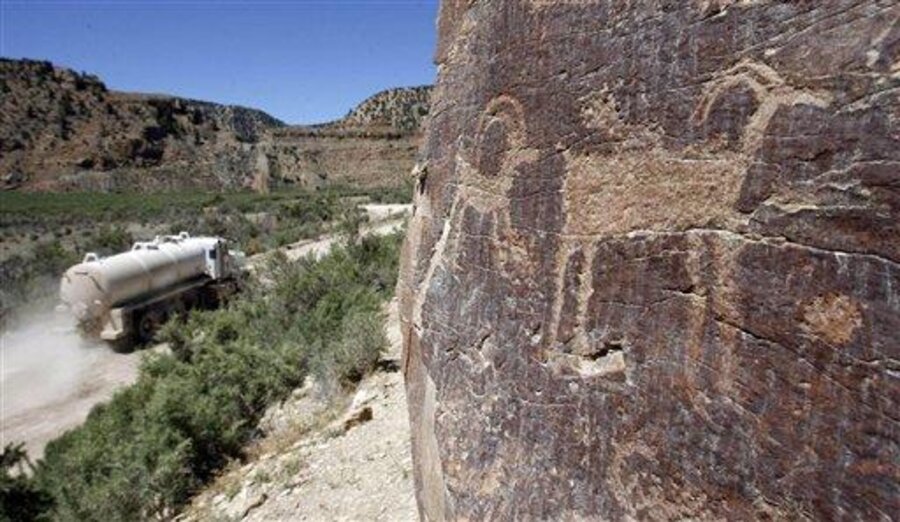Prehistoric Indian drawings to be protected in Utah canyon
Loading...
| Salt Lake City
An unusual agreement to protect a Utah canyon decorated by ancient American Indian art is expected to allow energy development to move forward.
The pact is scheduled to be signed today by federal and state agencies, conservation and archaeology groups, tribal leaders, and a Denver-based natural gas producer.
It calls for road work to cut down on abrasive dust that can erode the rock art panels of Nine Mile Canyon.
The canyon — actually 78 miles long — has been called the world's longest art gallery, with thousands of prehistoric drawings.
Bill Barrett Corp. is awaiting federal environmental approval to add 800 gas wells on high plateaus that are accessible only from Nine Mile Canyon.
The company says it was happy to end years of dispute with an agreement that brought an unprecedented level of scrutiny to its project.
"We were able to come to some agreement on practices necessary to protect the archaeological resources in the canyon. It's a step to developing the gas reserves, and we look forward to working on solutions to protect wildlife and the area's wilderness character," Duane Zavadil, the company's vice president for government affairs, told The Associated Press on Wednesday.
The agreement brings two practical changes to Nine Mile Canyon, which will see ramped up truck traffic as the gas wells are developed. Bill Barrett is likely to apply processed oil sands to harden the road and more permanently cut down on dust.
That step could prove more economical and effective than the alternative, repeated applications of a pine-based tar, Zavadil says.
The pact also compels the Bureau of Land Management to monitor and protect the entire canyon, from rim to rim, which spans miles.
Legally, the Bureau of Land Management was required only to protect lands within a 200-foot road corridor, and it resisted taking on a wider responsibility for energy development, according to preservation groups.
The BLM's Utah director, Selma Sierra, praised the agreement in a news release late Tuesday as a product of unusual collaboration that "helps us effectively meet the challenge of managing public lands for multiple uses."
But Ms. Sierra had resisted consulting such a wide variety of interests for years, which served only to delay Bill Barrett's project, says Jerry Spangler, executive director of the Colorado Plateau Archaeological Alliance, an organization devoted to protecting prehistoric sites.
Asked through a spokeswoman about her reservations, Sierra issued a statement that didn't directly address the question. Instead, she says her agency was moving on its own to limit damage from "industrial traffic" and will hire experts to regularly clean art panels.
The other principals to the pact are the National Trust for Historic Preservation, the Utah State Historic Preservation Office, the Utah State Public Lands Policy Coordinating Office and Carbon and Duchesne counties. Also weighing in were the Nine Mile Canyon Coalition, the Utah Rock Art Research Association, the Utah Professional Archaeological Council and the Southern Utah Wilderness Alliance.
The BLM is expected to issue its final environmental findings in two months, paving the way for gas drilling on Utah's West Tavaputs Plateau, the high rise of land surrounding Nine Mile Canyon. Bill Barrett Corp. has been seeking the approval since 2004.
The protection agreement surfaced little more than a month after the BLM announced it was nominating 63 of Nine Mile Canyon's artworks for the National Register of Historic Places. The agency says it would nominate some 800 more sites in the coming years.
Nine Mile Canyon contains more than 10,000 prehistoric rock carvings and paintings of bighorn sheep, owls, a two-headed snake, spear-wielding hunters and warriors engaged in hand-to-hand combat.
"The rock art and archaeological sites on the West Tavaputs Plateau are everyone's heritage," says Wilson Martin, Utah's historic preservation officer. "They are priceless.
Editor’s note: The Monitor's Environment section has a new URL. And there's a new URL for its Bright Green blog. We hope you'll bookmark these and visit often.





